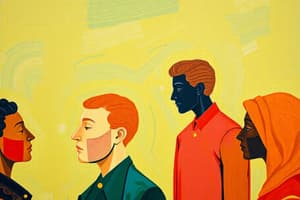Podcast
Questions and Answers
What is the difference between prejudice, discrimination, and stereotypes? Give examples of each.
What is the difference between prejudice, discrimination, and stereotypes? Give examples of each.
Prejudice is a preconceived negative judgment of a group (e.g., weight discrimination). Discrimination is unjustified negative behavior towards a group (e.g., not hiring an overweight person). Stereotype is a belief about the attributes of a group (e.g., overweight people are lazy).
Describe the procedure used by Jane Elliott to create prejudice and discrimination.
Describe the procedure used by Jane Elliott to create prejudice and discrimination.
Jane Elliott used eye color to determine superiority; blue-eyed people were given privileges while brown-eyed people were not. This led to outperforming on standardized tests by the 'superior' group.
What is the difference between implicit and explicit prejudice? Give examples of each.
What is the difference between implicit and explicit prejudice? Give examples of each.
Implicit prejudice is automatic, like being surprised a boss is a woman. Explicit prejudice is conscious, such as believing men are better leaders.
What evidence shows that explicit prejudice has decreased over the years?
What evidence shows that explicit prejudice has decreased over the years?
What scale is used to measure overt attitudes towards racism?
What scale is used to measure overt attitudes towards racism?
Summarize the method and results of Weitz's experiment on subtle racism.
Summarize the method and results of Weitz's experiment on subtle racism.
What do Gaertner and Dovidio propose in their theory of aversive racism?
What do Gaertner and Dovidio propose in their theory of aversive racism?
Summarize Gaertner and Dovidio's (1977) experiment on aversive racism and helping behavior.
Summarize Gaertner and Dovidio's (1977) experiment on aversive racism and helping behavior.
Flashcards are hidden until you start studying
Study Notes
Prejudice, Discrimination, and Stereotypes
- Prejudice: Negative judgment about a group; for example, weight discrimination against overweight individuals.
- Discrimination: Unjust behaviors toward individuals based on group membership; an example includes not hiring an overweight person.
- Stereotype: Oversimplified belief about a group's attributes; one common stereotype is that overweight people are lazy.
Jane Elliott's Experiment
- Superiority by Eye Color: Jane Elliott used eye color to create a faux hierarchy, paralleling racial discrimination.
- Privilege Distribution: The "superior" blue-eyed children received privileges, fostering a sense of superiority.
- Testing Outcomes: At the end of the exercise, blue-eyed children outperformed brown-eyed peers in standardized tests.
Implicit vs. Explicit Prejudice
- Implicit Prejudice: Unconscious attitudes that can surprise individuals; for instance, a person might be surprised if their boss is a woman.
- Explicit Prejudice: Conscious beliefs about group superiority, such as the viewpoint that men are better leaders.
Decline of Explicit Prejudice Evidence
- Electoral Milestone: The election of Barack Obama signifies a decrease in blatant forms of prejudice.
- Detection Challenges: Implicit prejudices remain difficult to identify in studies due to demand characteristics where participants modify behavior based on cues.
- Persistence of Issues: Although overt prejudice has lessened, it still exists and is more challenging to detect.
Modern Racism Scale
- Measuring Overt Attitudes: The scale uses a 5-point Likert format for responses.
- Key Statements: Items reflect perceptions about government respect for Black individuals, perceived discrimination levels, and opinions on racial integration.
Weitz's Experiment on Subtle Racism
- Participants: 80 northern male undergraduates participated in the study focusing on racial attitudes.
- Experiment Structure: Participants interacted with a confederate (either Black or white) and rated initial impressions on various traits.
- Results: Higher friendliness ratings for Black partners correlated with less vocal warmth and fewer hours volunteered for future work together, emphasizing disparities in overt and covert racism measures.
Aversive Racism Theory
- Underlying Inconsistency: Many white Americans view themselves as non-racist but harbor unacknowledged discomfort or fear around Black individuals.
- Egalitarian Values: Whites may espouse egalitarian beliefs while simultaneously experiencing negative feelings towards Blacks, particularly in ambiguous situations.
Gaertner and Dovidio's Experiment on Aversive Racism
- Sample Group: 75 white female participants were selected based on their scores on overt racial prejudice.
- Experiment Design: The study involved a supposed telepathy experiment where confederates (Black or white) were manipulated to observe helping behavior in an ambiguous context.
- Manipulated Variables: The number of receivers (1 or 3) and the race of the sender (Black or white) were key factors in the experiment's design.
Studying That Suits You
Use AI to generate personalized quizzes and flashcards to suit your learning preferences.




